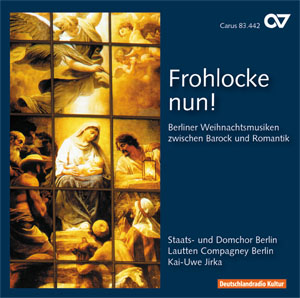
Frohlocke nun. Berliner Weihnachtsmusiken zwischen Barock und Romantik
During the 18th and early 19th centuries in Berlin, as elsewhere, the festival of Christmas was celebrated lavishly in music. What Christmas music was especially popular can be seen from a glance at the archive of the Berlin Sing-Akademie, long believed to be lost after World War II but returned from Kiev in 2001. This priceless source of information on Berlin’s 18th century musical history includes cantatas by Carl Philipp Emanuel Bach, Carl Heinrich Graun and Johann Friedrich Agricola which have now been issued in world premiere recordings. Other titles indicate church music tendencies of that period: from Reichardt’s rustic idylle in the style of folk music to Zelter’s return to the tradition of Palestrina. This recording with the Staats- and Domchor Berlin brings to light little-known musical treasures, and it also demonstrates the development of church music between the baroque and romantic periods in the musical life of Berlin.
Purchase
Additional product information
Contents
-
Preface writer
Christian Filips
-
Choir
Staats- und Domchor Berlin
-
Ensemble
Lautten Compagney Berlin
The Lautten Compagney is one of the most renowned and creative baroque instrument ensembles in Germany. Their concerts, under the artistic direction of Wolfgang Katschner, have fascinated audiences for three decades. With their infectious joy in performing and their innovative concepts, these ‘early musicians’ effortlessly translate the musical language of the Baroque to the present. Whether it’s as a solo chamber ensemble or an opera orchestra, the ensemble is continually crossing boundaries and seeking out encounters with new sounds and other art forms. The ensemble has received numerous awards for its exciting musical collaborations. For its CD recording of the program Timeless, combining early Baroque music with works by Philip Glass, it received an ECHO Klassik award in 2010. And their winning the Rheingau Musik Prize 2012 was in recognition of the Lautten Compagney’s creative concert programming. The ensemble has a particular interest in music theater, especially the works of George Frideric Handel. Their performances of Handel’s Serse on a tour of New Zealand in 2011 took both audiences and press by storm. Their production of Rinaldo, a collaboration with the Milan puppet company Carlo Colla e Figli, was enthusiastically received by young and old alike. The Lautten Compagney is a regular guest at leading national and international concert halls and festivals, including the Konzerthaus and Radialsystem V in Berlin, the Leipzig Gewandhaus, Frauenkirche Dresden, Concertgebouw Amsterdam, Vienna Musikverein, Warsaw Philharmonic, An unmistakable sound, breathtaking blend, tremendous sense of musical assurance and a good portion of charm and wit are amarcord’s special hallmarks. The group’s extremely diverse and wide-ranging repertoire encompasses medieval songs, Renaissance madrigals and masses, compositions and cycles of works from the European Romantic and 20th century as well as a cappella arrangements of folk songs from all over the world, and well-known rock, pop, soul, and jazz songs. The ensemble has won prizes at numerous international competitions. In 2002 amarcord won the Deutscher Musikwettbewerb. Alongside the Gewandhaus Orchestra and St. Thomas’s Choir, amarcord is one of the most important representatives of the music city of Leipzig at home and abroad. The group is a frequent guest at leading music festivals. Numerous concert tours have taken the singers to over fifty countries and to almost every continent in the world. In association with the Goethe-Institut they have given guest performances in Australia, South East Asia, the Middle East, Russia, Africa, and Central America. The International Festival for Vocal Music “a cappella” (www.a-cappella-festival.de), inaugurated by amarcord in 1997, has become one of the most important festivals of its kind under the group’s artistic direction. Numerous CDs impressively document the different facets of amarcord’s repertoire, and have won many prizes such as ECHO Klassik (2010, 2012), the International Classical Music Award, Supersonic Award and the Contemporary A Cappella Recording Award. Personal details
-
Conductor
Kai-Uwe Jirka
-
Soloist - soprano
Dennis Chmelensky
-
Soloist - alto
Olivia Vermeulen
-
Soloist - tenor
Jan Kobow
-
Soloist - tenor
Patrick Vogel
-
Soloist - bass
Matthias Vieweg
Reviews
[...] I your're looking for a very pleasant but unusual Christmas CD, then look no further! [...]
Early Music Review, December 2009
Early Music Review, December 2009
Frequent questions about this work
 There are no questions and answers available so far or you were unable to find an answer to your specific question about this work? Then click here and send your specific questions to our Customer Services!
There are no questions and answers available so far or you were unable to find an answer to your specific question about this work? Then click here and send your specific questions to our Customer Services!





